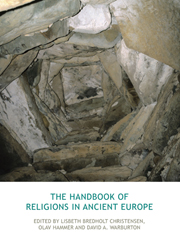Book contents
- Frontmatter
- Contents
- A note on Greek and Latin sources
- Abbreviations and short titles
- 1 Introduction
- PART I PREHISTORIC RELIGIONS
- PART II ANCIENT EUROPE IN THE HISTORICAL PERIOD
- 12 Minoan and Mycenaean religion
- 13 Etruscan religion
- 14 The religions of the Iberian Peninsula
- 15 Italic religion
- 16 Roman religion
- 17 Ancient Greek religion
- 18 The Graeco-Roman cult of Isis
- 19 The cult of Mithras
- 20 Religious Platonism: philosophy and religion in the Platonic tradition
- 21 Insular Celtic religion
- 22 Continental Germanic religion
- 23 Pre-Christian Anglo-Saxon religion
- 24 Old Norse religion
- 25 Slavic religion
- 26 Baltic religion
- 27 Religion in prehistoric Finland
- 28 Sami religion
- Timeline of key dates
- Contributors
- References
- Index
26 - Baltic religion
from PART II - ANCIENT EUROPE IN THE HISTORICAL PERIOD
- Frontmatter
- Contents
- A note on Greek and Latin sources
- Abbreviations and short titles
- 1 Introduction
- PART I PREHISTORIC RELIGIONS
- PART II ANCIENT EUROPE IN THE HISTORICAL PERIOD
- 12 Minoan and Mycenaean religion
- 13 Etruscan religion
- 14 The religions of the Iberian Peninsula
- 15 Italic religion
- 16 Roman religion
- 17 Ancient Greek religion
- 18 The Graeco-Roman cult of Isis
- 19 The cult of Mithras
- 20 Religious Platonism: philosophy and religion in the Platonic tradition
- 21 Insular Celtic religion
- 22 Continental Germanic religion
- 23 Pre-Christian Anglo-Saxon religion
- 24 Old Norse religion
- 25 Slavic religion
- 26 Baltic religion
- 27 Religion in prehistoric Finland
- 28 Sami religion
- Timeline of key dates
- Contributors
- References
- Index
Summary
The ancient Baits comprised tribes that later consolidated into three larger ethnic groups: Lithuanians, Latvians and Prussians. Together, they constituted the Baltic cultural and linguistic unit. Most of the Old Prussians who lived in the territory of eastern Germany, northern Poland and the Curonian Spit (or Kurshi Inlet) were exterminated during the period of Germanic expansion in the fourteenth century; those remaining were assimilated and had disappeared as a separate ethnic group by the seventeenth century. Nowadays the Prussian language is being revived artificially. In modern Europe, Lithuanian and Latvian are in many respects the linguistically most archaic spoken Indo-European languages. Though culturally and linguistically close, contemporary Lithuanians and Latvians differ genetically. Recent human DNA analyses show that Latvians are genetically closer to the Finno-Ugrian-speaking Estonians. The reason might be that the territory of contemporary Latvia from the middle of the second millennium BCE constituted a kind of melting pot for numerous ethnic groups. When the Baltic peoples at this time arrived in present-day Latvian territory it was partly inhabited by Finno-Ugrian-speaking tribes who had settled along the Baltic coast and the banks of the river Daugava. At that time, as shown by hydronyms, the territory inhabited by the Baltic tribes extended beyond Moscow east-wards and across the banks of the river Vistula southwards.
As early as the first millennium BCE, these relatively isolated peoples had switched from a hunting and fishing mode of subsistence to an agrarian culture.
- Type
- Chapter
- Information
- The Handbook of Religions in Ancient Europe , pp. 359 - 371Publisher: Acumen PublishingPrint publication year: 2013



